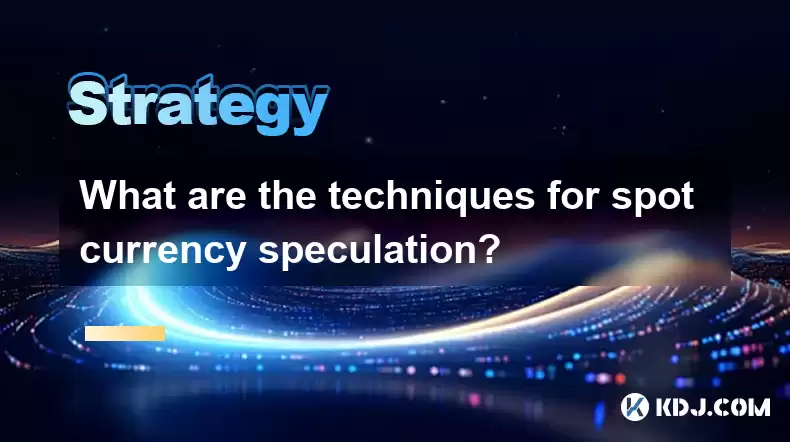-
 bitcoin
bitcoin $95203.028270 USD
-4.12% -
 ethereum
ethereum $3151.730711 USD
-1.61% -
 tether
tether $0.999170 USD
-0.04% -
 xrp
xrp $2.273039 USD
-1.55% -
 bnb
bnb $924.288432 USD
0.14% -
 solana
solana $141.112899 USD
-2.02% -
 usd-coin
usd-coin $0.999964 USD
0.02% -
 tron
tron $0.293976 USD
0.82% -
 dogecoin
dogecoin $0.160772 USD
-1.84% -
 cardano
cardano $0.506357 USD
-3.90% -
 hyperliquid
hyperliquid $37.900515 USD
0.03% -
 zcash
zcash $644.358451 USD
26.66% -
 chainlink
chainlink $14.062007 USD
-2.60% -
 bitcoin-cash
bitcoin-cash $484.381072 USD
-5.12% -
 unus-sed-leo
unus-sed-leo $9.199874 USD
0.27%
What are the techniques for spot currency speculation?
Spot currency speculation involves analyzing historical price data through technical analysis, using trendlines and indicators to identify trends, and utilizing position sizing and stop-loss orders for effective risk management.
Jan 09, 2025 at 07:39 am

- Understanding Technical Analysis
- Identifying Market Trends
- Utilizing Trading Indicators
- Developing a Trading Strategy
- Risk Management Techniques
Technical analysis is a trading method that involves studying historical price data to identify patterns and predict future price movements. It relies on charts to plot price data, such as candlesticks or line graphs, and uses various indicators and patterns to analyze market behavior. Technical analysts believe that price action contains valuable information about supply and demand, and by studying these patterns, traders can make informed predictions about future price movements.
2. Identifying Market TrendsIdentifying market trends is crucial for successful spot currency speculation. By recognizing the overall direction of the market, traders can capitalize on momentum and trend following strategies. Several methods can be used to identify trends, such as trendlines, moving averages, and support and resistance levels. Understanding market trends requires patience and observational skills, as trends can evolve over different timeframes.
3. Utilizing Trading IndicatorsTechnical and momentum indicators provide valuable insights into market conditions and assist in making trading decisions. Relative Strength Index (RSI), Moving Average Convergence Divergence (MACD), and Bollinger Bands are commonly used indicators that measure price momentum, overbought/oversold conditions, and volatility. Traders can also employ trend-following indicators like Parabolic SAR or Ichimoku Cloud to identify potential entry and exit points.
4. Developing a Trading StrategyA well-defined trading strategy is essential for consistent spot currency speculation success. This strategy should outline the specific rules, criteria, and approach that guide traders in their trading activities. It includes defining clear entry and exit points, position sizing, and risk management guidelines. A comprehensive trading strategy ensures disciplined trading practices and minimizes impulsive decisions.
5. Risk Management TechniquesRisk management is paramount in spot currency speculation. Effective techniques include setting stop-loss orders to limit potential losses, using position sizing to manage exposure, and diversifying trades across different pairs. Additionally, leverage should be employed with caution, as it can amplify both profits and losses. Understanding risk-reward ratios helps traders make informed decisions about potential rewards versus potential losses.
FAQs:What is the most profitable trading strategy?The most profitable trading strategy depends on individual preferences, market conditions, and risk appetite. No single strategy guarantees success, and traders must adapt their approaches based on market dynamics and their risk tolerance.
How much capital is needed for spot currency trading?The amount of capital required depends on the trading method, leverage used, and personal financial situation. It is recommended to start with a small amount that can be lost without financial hardship.
What is a good risk-reward ratio?A good risk-reward ratio generally falls between 1:2 and 1:5. This means that a trader is willing to risk $1 for the potential to earn between $2 and $5. A higher ratio indicates a more aggressive risk appetite.
How often should I review my trading strategy?A trading strategy should be reviewed regularly, typically every few months, to ensure it remains effective. Market conditions can change over time, and adjustments may be necessary to adapt to these evolving dynamics.
Disclaimer:info@kdj.com
The information provided is not trading advice. kdj.com does not assume any responsibility for any investments made based on the information provided in this article. Cryptocurrencies are highly volatile and it is highly recommended that you invest with caution after thorough research!
If you believe that the content used on this website infringes your copyright, please contact us immediately (info@kdj.com) and we will delete it promptly.
- Decoding the Crypto Crystal Ball: Will Apeing Outpace XRP and BNB in 2025?
- 2025-11-15 12:25:02
- HBAR, Zero Knowledge, and the Privacy Revolution: What's the Smart Money Doing?
- 2025-11-15 11:40:02
- Crypto Presales Face-Off: Is Digitap ($TAP) Really Toppling BlockDAG?
- 2025-11-15 11:35:01
- Tokenization, 24/7 Markets, and Vlad Tenev: The Future of Finance?
- 2025-11-15 11:30:01
- Bull Market Bonanza: Crypto Presales and Explosive Growth Opportunities
- 2025-11-15 11:25:01
- Crypto Carnage: Navigating Selling and Liquidations in a Wild Market
- 2025-11-14 16:50:01
Related knowledge

The Complete Guide to Liquidity Mining: Earning Rewards in DeFi.
Nov 14,2025 at 12:40am
Understanding Decentralized Exchanges in the Crypto Ecosystem1. Decentralized exchanges (DEXs) operate without a central authority, allowing users to ...

How to Research a Crypto Project: A Guide to Avoiding Rug Pulls.
Nov 14,2025 at 09:20pm
Understanding Decentralized Exchanges in the Crypto Ecosystem1. Decentralized exchanges (DEXs) have emerged as a pivotal component of the cryptocurren...

A Beginner's Guide to Crypto Wallets: How to Secure Your Digital Assets.
Nov 14,2025 at 11:39am
Understanding the Basics of Crypto Wallets1. A crypto wallet is not a physical container but a digital tool that stores private and public keys, allow...

How to Build a Diversified Crypto Portfolio: A Guide for New Investors.
Nov 14,2025 at 12:59am
Understanding the Basics of Crypto Portfolio Diversification1. Cryptocurrency markets are known for their volatility, making diversification a crucial...

A Guide to Crypto Portfolio Rebalancing: Maximizing Gains and Minimizing Risk.
Nov 14,2025 at 08:20pm
Understanding Crypto Portfolio Rebalancing1. Cryptocurrency portfolio rebalancing refers to the process of realigning the weightings of digital assets...

How to Survive a Crypto Bear Market: Strategies for Protecting Your Capital.
Nov 14,2025 at 03:22am
Understanding the Crypto Bear Market1. A crypto bear market is characterized by prolonged price declines across major digital assets, often triggered ...

The Complete Guide to Liquidity Mining: Earning Rewards in DeFi.
Nov 14,2025 at 12:40am
Understanding Decentralized Exchanges in the Crypto Ecosystem1. Decentralized exchanges (DEXs) operate without a central authority, allowing users to ...

How to Research a Crypto Project: A Guide to Avoiding Rug Pulls.
Nov 14,2025 at 09:20pm
Understanding Decentralized Exchanges in the Crypto Ecosystem1. Decentralized exchanges (DEXs) have emerged as a pivotal component of the cryptocurren...

A Beginner's Guide to Crypto Wallets: How to Secure Your Digital Assets.
Nov 14,2025 at 11:39am
Understanding the Basics of Crypto Wallets1. A crypto wallet is not a physical container but a digital tool that stores private and public keys, allow...

How to Build a Diversified Crypto Portfolio: A Guide for New Investors.
Nov 14,2025 at 12:59am
Understanding the Basics of Crypto Portfolio Diversification1. Cryptocurrency markets are known for their volatility, making diversification a crucial...

A Guide to Crypto Portfolio Rebalancing: Maximizing Gains and Minimizing Risk.
Nov 14,2025 at 08:20pm
Understanding Crypto Portfolio Rebalancing1. Cryptocurrency portfolio rebalancing refers to the process of realigning the weightings of digital assets...

How to Survive a Crypto Bear Market: Strategies for Protecting Your Capital.
Nov 14,2025 at 03:22am
Understanding the Crypto Bear Market1. A crypto bear market is characterized by prolonged price declines across major digital assets, often triggered ...
See all articles









































































